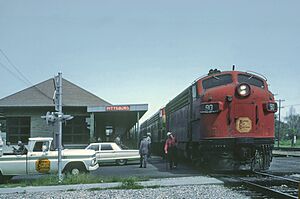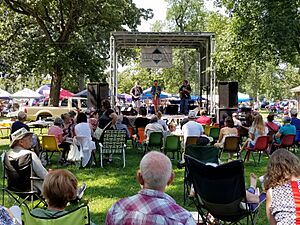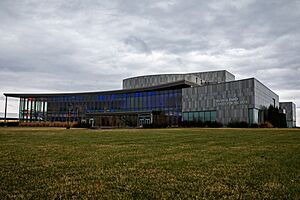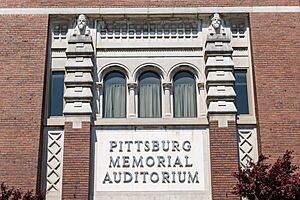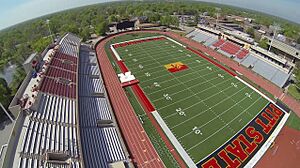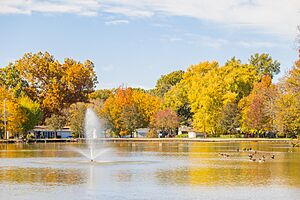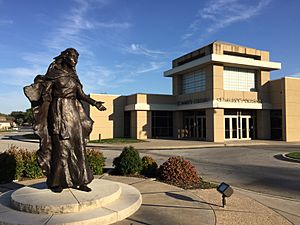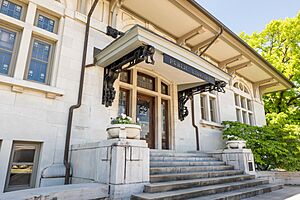Pittsburg, Kansas facts for kids
Quick facts for kids
Pittsburg, Kansas
|
|
|---|---|
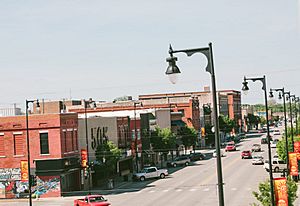
View of downtown Pittsburg (2017)
|
|

Location within Crawford County and Kansas
|
|

|
|
| Country | United States |
| State | Kansas |
| County | Crawford |
| Founded | 1876 |
| Incorporated | 1880 |
| Named for | Pittsburgh |
| Government | |
| • Type | Commission/Manager |
| Area | |
| • Total | 13.16 sq mi (34.09 km2) |
| • Land | 13.06 sq mi (33.84 km2) |
| • Water | 0.10 sq mi (0.25 km2) |
| Elevation | 925 ft (282 m) |
| Population
(2020)
|
|
| • Total | 20,646 |
| • Density | 1,568.8/sq mi (605.63/km2) |
| Time zone | UTC-6 (CST) |
| • Summer (DST) | UTC-5 (CDT) |
| ZIP code |
66762
|
| Area code | 620 |
| FIPS code | 20-56025 |
| GNIS ID | 485643 |
Pittsburg is a city in Crawford County, Kansas, United States. It is located in the southeastern part of Kansas, close to the Missouri state border. Pittsburg is the largest city in Crawford County and in southeast Kansas. In 2020, about 20,646 people lived there. It is also the home of Pittsburg State University.
Contents
History of Pittsburg
Pittsburg started in the fall of 1876 along a new railroad line. It was named after Pittsburgh, Pennsylvania. Early maps called it "New Pittsburgh." George Hobson and Franklin Playter are known as the city's founders. They helped set up a government after it began as a coal mining camp in the 1870s. The city officially became a city in 1879. The word "New" was dropped in 1880.
The first house was built by J. T. Roach in July 1876. The first post office opened in August 1876. Its name was changed from "New Pittsburgh" to "Pittsburgh" in 1881. Then it became "Pittsburg" in 1894. This happened because the U.S. Board on Geographic Names wanted to make names more standard. They suggested dropping the 'h' from place names ending in "burgh."
Pittsburg State University was founded in 1903. It started as a school to train teachers. Over the years, it grew into a larger university with many different programs. It is well-known for its manual and industrial arts programs.
In 1879, two miners started the first commercial coal mining near Broadway Street. The Pittsburg & Midway Coal Company was founded in 1885. It was one of the oldest coal companies in the U.S. Even though its main office moved, it was a big part of Pittsburg's history. Pittsburg was also a very strong union city in the early 1900s. Today, the city's economy relies on education and government jobs. It also has a rich cultural background from many European mine workers who settled there.
Geography and Climate
Pittsburg covers about 12.90 square miles (33.41 km2). Most of this area is land, with a small part being water. The city is located in the Ozark Highlands region. This area has a mix of open prairies and forests.
Pittsburg is about 90 miles (140 km) west of Springfield, Missouri. It is 124 miles (200 km) south of Kansas City, Missouri. It is also 137 miles (220 km) northeast of Tulsa, Oklahoma.
Pittsburg's Weather
Pittsburg has a humid subtropical climate. This means it has hot and humid summers. Temperatures can stay warm even at night. Sometimes, heavy thunderstorms bring a lot of rain during the summer.
In the fall, temperatures cool down quickly. Heavy rains from weather systems are common during this time. Fall can also see very wet periods.
Winters in Kansas can change a lot. Pittsburg can have very cold days, but also some warmer days. Snowfall is not usually very heavy. This is because moist air from the Gulf of Mexico often brings warmer temperatures.
Spring weather changes often and can bring strong storms. Pittsburg is in "Tornado Alley," so tornadoes are possible. Spring also brings a lot of rain. Temperatures warm up during spring, leading to hot summer days.
| Climate data for Pittsburg, Kansas (1991–2020 normals, extremes 1950–present) | |||||||||||||
|---|---|---|---|---|---|---|---|---|---|---|---|---|---|
| Month | Jan | Feb | Mar | Apr | May | Jun | Jul | Aug | Sep | Oct | Nov | Dec | Year |
| Record high °F (°C) | 74 (23) |
82 (28) |
87 (31) |
94 (34) |
94 (34) |
105 (41) |
115 (46) |
109 (43) |
106 (41) |
96 (36) |
83 (28) |
75 (24) |
115 (46) |
| Mean daily maximum °F (°C) | 42.7 (5.9) |
48.3 (9.1) |
58.7 (14.8) |
68.0 (20.0) |
76.4 (24.7) |
85.5 (29.7) |
90.2 (32.3) |
89.8 (32.1) |
82.2 (27.9) |
70.0 (21.1) |
57.2 (14.0) |
46.0 (7.8) |
67.9 (19.9) |
| Daily mean °F (°C) | 33.2 (0.7) |
38.2 (3.4) |
47.7 (8.7) |
57.0 (13.9) |
66.0 (18.9) |
75.4 (24.1) |
80.1 (26.7) |
78.9 (26.1) |
70.9 (21.6) |
58.8 (14.9) |
46.4 (8.0) |
36.8 (2.7) |
57.4 (14.1) |
| Mean daily minimum °F (°C) | 23.8 (−4.6) |
28.2 (−2.1) |
36.7 (2.6) |
46.0 (7.8) |
55.6 (13.1) |
65.2 (18.4) |
70.1 (21.2) |
67.9 (19.9) |
59.7 (15.4) |
47.7 (8.7) |
35.6 (2.0) |
27.5 (−2.5) |
47.0 (8.3) |
| Record low °F (°C) | −6 (−21) |
−12 (−24) |
2 (−17) |
20 (−7) |
32 (0) |
47 (8) |
52 (11) |
46 (8) |
38 (3) |
20 (−7) |
9 (−13) |
−3 (−19) |
−12 (−24) |
| Average precipitation inches (mm) | 1.77 (45) |
2.10 (53) |
3.24 (82) |
5.06 (129) |
7.13 (181) |
6.07 (154) |
4.50 (114) |
3.64 (92) |
5.18 (132) |
3.61 (92) |
3.29 (84) |
2.30 (58) |
47.89 (1,216) |
| Average snowfall inches (cm) | 3.4 (8.6) |
1.0 (2.5) |
1.6 (4.1) |
0.0 (0.0) |
0.0 (0.0) |
0.0 (0.0) |
0.0 (0.0) |
0.0 (0.0) |
0.0 (0.0) |
0.0 (0.0) |
0.6 (1.5) |
2.9 (7.4) |
9.5 (24) |
| Average precipitation days (≥ 0.01 in) | 7.4 | 7.2 | 9.8 | 10.6 | 12.1 | 10.1 | 8.6 | 7.5 | 7.6 | 8.1 | 7.7 | 7.5 | 104.2 |
| Average snowy days (≥ 0.1 in) | 2.2 | 1.2 | 0.7 | 0.0 | 0.0 | 0.0 | 0.0 | 0.0 | 0.0 | 0.0 | 0.3 | 1.5 | 5.9 |
| Source: NOAA | |||||||||||||
Pittsburg's Population
| Historical population | |||
|---|---|---|---|
| Census | Pop. | %± | |
| 1880 | 624 | — | |
| 1890 | 6,697 | 973.2% | |
| 1900 | 10,112 | 51.0% | |
| 1910 | 14,755 | 45.9% | |
| 1920 | 18,052 | 22.3% | |
| 1930 | 18,145 | 0.5% | |
| 1940 | 17,571 | −3.2% | |
| 1950 | 19,341 | 10.1% | |
| 1960 | 18,678 | −3.4% | |
| 1970 | 20,171 | 8.0% | |
| 1980 | 18,770 | −6.9% | |
| 1990 | 17,775 | −5.3% | |
| 2000 | 19,243 | 8.3% | |
| 2010 | 20,233 | 5.1% | |
| 2020 | 20,646 | 2.0% | |
| U.S. Decennial Census 2010-2020 |
|||
Population in 2020
In 2020, Pittsburg had 20,646 people living in 8,268 households. The population density was about 1,579 people per square mile. Most residents (77.27%) were White. Other groups included African American (3.74%), Native American (1.07%), and Asian (1.78%). About 10.53% of the population was Hispanic or Latino.
About 27.1% of households had children under 18. The average household had 2.3 people. The average family had 3.0 people. The median age in the city was 27.7 years. About 21.9% of the population was under 18.
Population in 2010
In 2010, Pittsburg had 20,233 people. There were 8,142 households. The population density was about 1,581 people per square mile. The racial makeup was mostly White (87.1%). Other groups included African American (3.3%), Native American (0.9%), and Asian (2.0%). Hispanic or Latino people made up 6.7% of the population.
About 24.6% of households had children under 18. The average household size was 2.31 people. The average family size was 2.97 people. The median age in the city was 26.2 years. About 20.7% of residents were under 18.
Arts and Culture in Pittsburg
Local Events
- Little Balkans Days: This is a three-day festival that celebrates the city's European heritage. It happens on Labor Day weekend. The festival includes games, entertainment, competitions, and arts and crafts.
- Pittsburg Art Walk: This event features vendors, artists, and musicians. It takes place several times a year on Broadway Street in downtown Pittsburg.
Places to Visit
- Bicknell Family Center for the Arts: This building has several halls for performances.
- Memorial Auditorium: Opened in 1925, this building has a special Egyptian Revival style. It hosts concerts and other shows.
- Pittsburg Aquatic Center: This is a community swimming pool where people can cool off.
- Carnie Smith Stadium: This stadium opened in 1924. It is the home football field for Pittsburg State University. It also has an outdoor track.
- Veteran's Memorial: This memorial has an amphitheater with 250 seats. It also features a replica of the Vietnam Veteran's Memorial Wall, a reflecting pool, and a plaza with many engraved stones.
- Crawford County Historical Museum: Here you can learn about the history of the area. It also includes the Green Elm School.
- Miners' Memorial and Immigrant Park: This park honors the city's mining history and the many immigrants who settled here.
Libraries in Pittsburg
- Pittsburg Public Library
- Leonard H. Axe Library at Pittsburg State University
Parks and Recreation
Pittsburg has many parks within its city limits for everyone to enjoy:
- 23rd Street Bike Park: A park for mountain biking with trails, a skills area, and dirt jumps.
- Countryside Park: Features a playground and a pavilion.
- Deramus Park: Has a basketball court, playground, and a small sports field.
- Europe Park: Known for its unique water features and a seating area.
- Kiwanis Park: Includes a playground and a pavilion.
- Lakeside Park: Has a lake, a fishing dock, a playground, two pavilions, and tennis courts.
- Lincoln Park: A large park with the J.J. Richards Band Dome, Kiddieland Amusement Park, Pittsburg Aquatic Center, Don Gutteridge Sports Complex, bocce courts, a disc golf course, fishing, and playgrounds.
- Paul B. Leffler Rotary Park: Offers a basketball court, grill, playground, and small sports fields.
- Schlanger Park: Features Katherine's playground (which is accessible for all), Ronald O. Thomas Dog Park, a basketball court, pickleball court, a sensory garden, two pavilions, a skate park, sand volleyball, and an 18-hole disc golf course.
- Sunflower Kiwanis Park: Has a playground and a pavilion.
- Trail Head Park/Watco Trail: Includes a pergola, benches, and a 1.5-mile paved trail for walking and biking.
- Wilderness Park: Offers four miles of trails and four fishing pits. Most of the trails are accessible.
Education in Pittsburg
Public Schools
The city's public schools are part of the Pittsburg USD 250 district. They include:
- Pittsburg High School
- Pittsburg Community Middle School
- George Nettels Elementary School
- Lakeside Elementary School
- Meadowlark Elementary School
- Westside Elementary School
Private Schools
- St. Mary's-Colgan High School: A Catholic school.
- Countryside Christian School: A private Christian school for grades K-8.
- Covenant Harvest: A Christian school.
Colleges and Universities
- Pittsburg State University
- Fort Scott Community College: Has a School of Cosmetology in Pittsburg.
- Labette Community College: Has a Cherokee Center in Pittsburg.
Media in Pittsburg
The main newspaper in Pittsburg is Pittsburg Morning Sun. It is published five days a week. Pittsburg State University also has its own weekly student newspaper called the Collegio.
Pittsburg is an important center for radio and television in southeastern Kansas. There are several radio stations that broadcast from the city. Pittsburg is also part of the Joplin-Pittsburg television market. Some major TV channels have their local stations broadcasting from Pittsburg.
Infrastructure
Public Transportation
- Bus System: Pittsburg has a bus system called Pittsburg Area Community Transit (P.A.C.T) and the Gus Bus.
- Taxi services: Taxis are available for getting around the city.
Airport
- Atkinson Municipal Airport: This airport has 41 aircraft based there.
Medical Care
- Via Christi Hospital: This hospital serves the area. It offers special services like Regional Cancer and Heart Centers.
Notable People
Many notable people have lived in or were born in Pittsburg. These include actor Roy Glenn, businessman and giver Kenneth A. Spencer, and early broadcast journalist Paul White.
See also
 In Spanish: Pittsburg (Kansas) para niños
In Spanish: Pittsburg (Kansas) para niños


